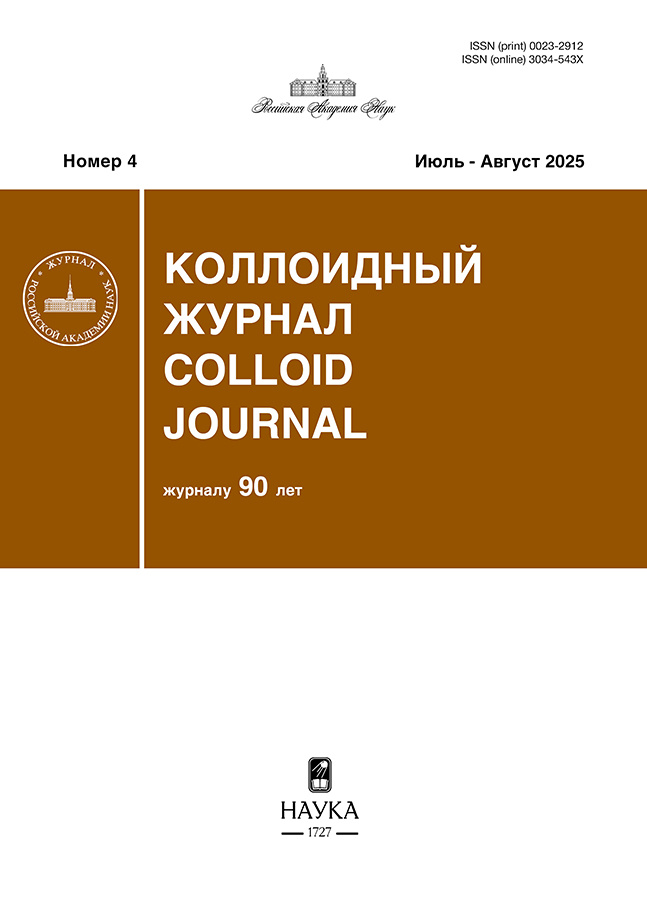The Effect of a Permeable Membrane on the Crystallization of a Simple Liquid
- Authors: Fomin Y.D.1, Tsiok E.N.1, Ryzhov V.N.1
-
Affiliations:
- Institute of High Pressure Physics named after L.F. Vereshchagin of the Russian Academy of Sciences
- Issue: Vol 87, No 4 (2025)
- Pages: 443-452
- Section: Articles
- Submitted: 07.10.2025
- Published: 15.08.2025
- URL: https://edgccjournal.org/0023-2912/article/view/692344
- DOI: https://doi.org/10.7868/S3034543X25040142
- EDN: https://elibrary.ru/nqbpav
- ID: 692344
Cite item
Abstract
The article discusses the deposition of gas onto a crystalline substrate provided there is a permeable membrane between the substrate and the gas. The membrane repels gas particles, but the repulsive potential has a finite maximum force, which allows gas particles to penetrate through this membrane if their velocity exceeds a certain value. It is shown that, depending on the maximum repulsive force of the membrane (the intensity of repulsion), the system comes to completely different end states: a single crystal, a polycrystal with varying degrees of porosity, or no crystallization occurs in the system at all.
Keywords
About the authors
Y. D. Fomin
Institute of High Pressure Physics named after L.F. Vereshchagin of the Russian Academy of Sciences
Email: fomin314@mail.ru
Kaluga Highway, 14, Troitsk, Moscow, 108840 Russia
E. N. Tsiok
Institute of High Pressure Physics named after L.F. Vereshchagin of the Russian Academy of SciencesKaluga Highway, 14, Troitsk, Moscow, 108840 Russia
V. N. Ryzhov
Institute of High Pressure Physics named after L.F. Vereshchagin of the Russian Academy of SciencesKaluga Highway, 14, Troitsk, Moscow, 108840 Russia
References
- Venable R.M., Krämer A., Pastor R.W. Molecular dynamics simulations of membrane permeability // Chem. Rev. 2019. V. 119. № 9. P. 5954–5997. https://doi.org/10.1021/acs.chemrev.8b00486
- A N.V.N., Jougnot D., Thanh L.D., et al. Predicting water flow in fully and partially saturated porous media: A new fractal-based permeability model // Hydrogeol. J. 2021. V. 29. P. 2017–2031. https://doi.org/10.1007/s10040-021-02364-6
- Yoshioka T., Kotaka K., Nakagawa K., et al. Molecular dynamics simulation study of polyamide membrane structures and RO/FO water permeation properties // Membranes. 2018. V. 8. № 4. P. 127. https://doi.org/10.3390/membranes8040127
- Gonçalves J.A., Batista R.J.C., Barbosa M.C. Water in nanoporous hexagonal boron nitride nanosheets: a first-principles study // Beilstein J. Nanotechnol. 2025. V. 16. P. 510–519. https://doi.org/10.3762/bjnano.16.39
- Kiran P.S., Indupuri S., Kumar K.V., et al. Fabrication of nanoporous multilayer graphene nanoplatelets membrane for water desalination // Desalination. 2024. V. 575. P. 117291. https://doi.org/10.1016/j.desal.2024.117291
- Tiwary S.K., Singh M., Chavan S.V., Karim A. Graphene oxide-based membranes for water desalination and purification // npj 2D Materials and Applications. 2024. V. 8. P. 27. https://doi.org/10.1038/s41699-024-00462-z
- Ali I., Zenab Hasan S., Garcia H., Danquah M.K., Imanova G. Recent advances in graphene-based nano-membranes for desalination // Chem. Eng. J. 2024. V. 483. P. 149108. https://doi.org/10.1016/j.cej.2024.149108
- Kim Y., Cruz S.S., Lee K., et al. Remote epitaxy through graphene enables two-dimensional material-based layer transfer // Nature. 2017. V. 544. P. 340–343. https://doi.org/10.1038/nature22053
- Ji J., Kwak H.M., Yu J., et al. Understanding the 2D-material and substrate interaction during epitaxial growth towards successful remote epitaxy: a review // Nano Convergence. 2023. V. 10. P. 19. https://doi.org/10.1186/s40580-023-00368-4
- Wang X., Choi J., Yoo J., Hong Y.J. Unveiling the mechanism of remote epitaxy of crystalline semiconductors on 2D materials-coated substrates // Nano Convergence. 2023. V. 10. P. 40. https://doi.org/10.1186/s40580-023-00387-1
- Frenkel D., Smit B. Understanding molecular simulation: From algorithms to applications, 3rd ed. Academic. New York. 2023.
- Ackland G.J., Jones A.P. Applications of local crystal structure measures in experiment and simulation // Phys. Rev. B. 2006. V. 73. P. 054104. https://doi.org/10.1103/PhysRevB.73.054104
- Stukowski A. Visualization and analysis of atomistic simulation data with OVITO – The open visualization tool // Modelling Simul. Mater. Sci. Eng. 2010. V. 18. P. 015012. https://doi.org/10.1088/0965-0393/18/1/015012
- Thompson A.P., Aktulga H.M., Berger R., et al. LAMMPS - A flexible simulation tool for particle-based materials modeling at the atomic, meso, and continuum scales // Computer Physics Communications. 2022. V. 271. P. 108171. https://doi.org/10.1016/j.cpc.2021.108171
Supplementary files










